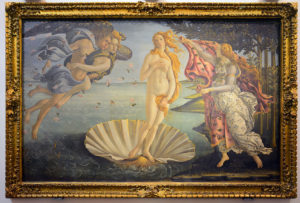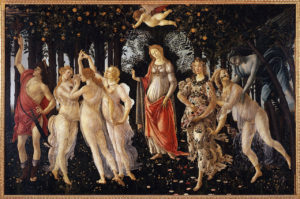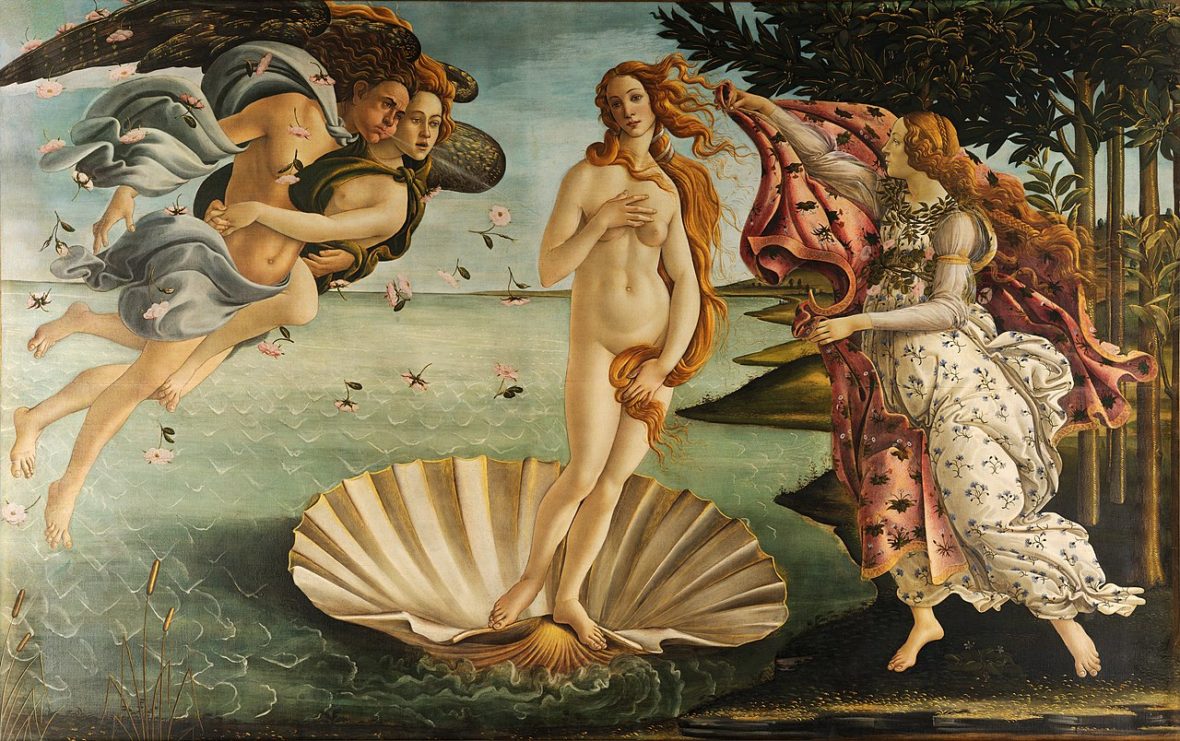The Birth of Venus is a painting done by Sandro Botticelli in the mid 1480s. It shows the goddess Venus arriving at the shore after her birth, she had emerged from the sea fully grown. The painting is currently in the Uffizi Gallery in Florence, Italy. Take a look below for 22 more interesting and fun facts about The Birth of Venus painting.
1. The Birth of Venus actually has several gods in it. Venus stands on the seashell being blown to shore by Zephyr, the god of the west wing. Horae, goddesses of the seasons, are also there ready with a cape to clothe new newborn deity.
2. The shell that Venus stands on may represent female genitalia, which creates a birthing scene reflected in Venus’ oceanic origins, while also symbolizing human birth.
3. The fact that Venus was naked in the painting was groundbreaking at the time. During the Middle Ages, almost all art was Christian based, therefore, nudity was rarely if ever portrayed.
4. The Birth of Venus is one of the first works on canvas in Tuscany. During the Early Renaissance, paintings on wood panels were popular, so this was seen as unique.
5. The painting wasn’t meant to be viewed in public. In fact, it was meant to hang over a marital bed.
6. La Primavera is a sort of sequel to The Birth of Venus. La Primavera shows the world in blood around the now-clothed maternal figure, who we assume is Venus.

7. The painting itself is massive, measuring at about 6 by 9 feet. It’s been called the first large-scale canvas created in Renaissance Florence.
8. On February 7, 1497, Dominican friar Girolamo Savonarola spurred the Christians in Florence to burn art and any other baubles like mirrors, jewelry and dice. However, The Birth of Venus managed to survive.
9. Over the centuries, coats of varnish that were meant to preserve the painting began to turn opaque, which hid some of Botticelli’s details and colors from view.
10. A restoration in 1987 gently stripped the varnish layer away, revealing soft and pearly colors that the artist intended. However, since the painting is so old, the colors have lost their luster.
11. Botticelli’s inspiration for Venus’s posture came from art that dated back to the second or third century BCE.
12. Some scholars believe that The Birth of Venus was modeled after the long lost Venus Anadyomene, a painting by the ancient Greek artist Apelles that was once described by the Roman author Pliny the Elder.
13. It took Botticelli 400 years to gain any fame from The Birth of Venus. He was largely overshadowed by the artists of the High Renaissance.
14. The Birth of Venus became the marker by which other eras’ beauty norms were measured. In fact, as recently as 2014, The Birth of Venus has been used as a tool to criticize modern beauty standards.
15. Before he died, Botticelli asked to be buried under his inspiration, Simonetta Cattaneo de Vespucci. Many scholars believe that she was his main inspiration for Venus.
16. Many people believe that Botticelli was commissioned to paint The Birth of Venus by the Medici family of Florence, maybe by Lorenzo di Pierfrancesco de’ Medici. He was a major patron of Botticelli, under the influence of his cousin Lorenzo de’ Medici.

17. Herbert Home in his monograph of 1908, stated that he believed the painting was commissioned after the purchase of the Villa di Castello in 1477.
18. The theme of The Birth of Venus was taken from the writings of the ancient poet, Homer.
19. According to legend, after Venus was born, she rode on a seashell and seafoam to the island of Cythera.
20. Botticelli paid a lot of attention to Venus’ hair and hairstyle, which reflected his interest in the way women wore their long hair in the late 15th century. He gave Venus an idealized face which was free of any imperfections.
21. While painting Venus, Botticelli painted a dark line around the contours of her body. This made it easier to see her bodily forms against the background, and it emphasized the color of her pale skin.
22. Some people believe that the nudity of Venus represents Eve in the Garden of Eden. This has led to people speculating that Venus is a personification of the Christian Church.




